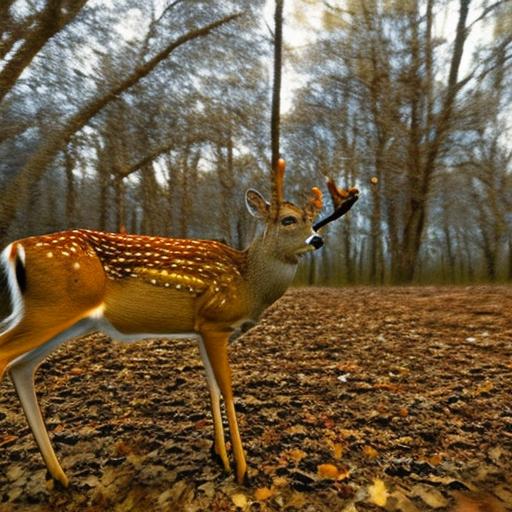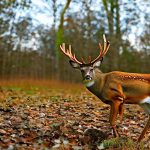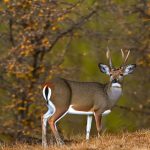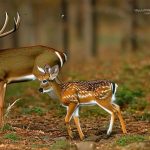Your cart is currently empty!

facts about hunting deer

Deer hunting is a popular activity in the United States, attracting millions of hunters each year. It is not only a sport but also a means of conservation and population control. Deer hunting has a rich history that dates back centuries, and it has evolved from a means of survival to a recreational activity enjoyed by many. In this article, we will explore the history of deer hunting, the most popular deer species for hunting, the best time of year to hunt deer, the tools and equipment needed for deer hunting, safety precautions, the benefits of deer hunting for conservation efforts, the impact of hunting on deer populations, the role of hunting in controlling deer overpopulation, the ethics of hunting deer, and the economic impact of deer hunting on local communities.
Key Takeaways
- Deer hunting has a long history, starting as a means of survival and evolving into a popular sport.
- The most popular deer species for hunting in North America are white-tailed deer and mule deer.
- The best time of year to hunt deer varies by region, but generally falls in the fall and winter months.
- Hunters need a variety of tools and equipment, including firearms, ammunition, and clothing, to successfully hunt deer.
- Safety precautions are crucial when hunting deer, including wearing blaze orange and practicing proper firearm handling.
- Deer hunting can benefit conservation efforts by controlling deer populations and funding wildlife management programs.
- Hunting can impact deer populations, but responsible hunting practices can help maintain healthy populations.
- Hunting can play a role in controlling deer overpopulation, which can have negative impacts on ecosystems.
- Ethical hunting practices include fair chase and responsible use of the animal after the hunt.
- Deer hunting can have a significant economic impact on local communities, including through the sale of hunting licenses and equipment.
The history of deer hunting: from survival to sport
Deer hunting has been a part of human history for thousands of years. Native Americans were among the first to hunt deer for survival, using their meat for food and their hides for clothing and shelter. Early settlers in America also relied on deer hunting as a means of survival. However, as civilization advanced and food became more readily available, deer hunting began to transition from a necessity to a sport.
In the 19th century, deer hunting became increasingly popular among wealthy individuals who saw it as a form of recreation. They would organize elaborate hunts with large groups of people and compete to see who could bag the biggest buck. This tradition continues today, with many hunters participating in organized hunts and competitions.
The most popular deer species for hunting
There are several species of deer that are popular for hunting in the United States. The most common species include white-tailed deer, mule deer, black-tailed deer, and elk.
White-tailed deer are the most widespread and abundant species in North America. They are known for their white tail that they raise when alarmed. White-tailed deer are found in a variety of habitats, including forests, fields, and even suburban areas. They are known for their agility and speed, making them a challenging target for hunters.
Mule deer are another popular species for hunting. They are larger than white-tailed deer and have distinctive large ears. Mule deer are found in the western United States and are known for their ability to survive in harsh environments. They are often found in mountainous regions and can be difficult to hunt due to their keen senses.
Black-tailed deer are a subspecies of mule deer and are found along the west coast of North America. They are smaller than mule deer and have a darker coat. Black-tailed deer are known for their elusive nature and can be a challenging target for hunters.
Elk, also known as wapiti, are the largest species of deer in North America. They are found in the western United States and are known for their impressive antlers. Elk hunting is a popular activity among hunters due to the challenge and thrill of pursuing such a majestic animal.
The best time of year to hunt deer
The best time of year to hunt deer depends on several factors, including the species of deer, the location, and the hunting season. In general, there are three main seasons for deer hunting: archery season, rifle season, and muzzleloader season.
Archery season typically takes place in the early fall when deer are still in their summer patterns. This is a popular time to hunt because the weather is mild, and deer are more predictable in their movements. However, archery hunting requires a higher level of skill and patience, as hunters must get closer to their prey.
Rifle season usually takes place in late fall or early winter when deer are in their rutting season. This is when bucks are most active and can be easier to spot. Rifle hunting allows hunters to take down deer from a distance, making it a popular choice for many.
Muzzleloader season is typically the last season of the year and takes place in late winter. This season is popular among hunters who enjoy the challenge of using a muzzleloader, which requires more skill and precision than a rifle.
The best time of day to hunt deer is during the early morning or late afternoon when deer are most active. During these times, deer are more likely to be feeding or moving to and from their bedding areas.
The tools and equipment needed for deer hunting
To hunt deer effectively, hunters need to have the right tools and equipment. The most essential items include a hunting rifle or bow, ammunition or arrows, a hunting knife, binoculars, and a backpack.
For rifle hunting, hunters should choose a caliber that is appropriate for the size of the deer they are hunting. Popular calibers for deer hunting include .270 Winchester, .30-06 Springfield, and .308 Winchester. It is important to practice shooting with your rifle before going on a hunt to ensure accuracy and familiarity with your weapon.
For archery hunting, hunters will need a compound bow or recurve bow. It is important to choose a bow that is appropriate for your skill level and draw weight. Hunters should also have a supply of arrows and broadheads, which are used to take down the deer.
A hunting knife is an essential tool for field dressing and processing the deer after it has been harvested. A sharp knife with a sturdy blade is recommended for this task.
Binoculars are important for spotting deer from a distance and determining their size and antler configuration. A good pair of binoculars can make a significant difference in the success of a hunt.
A backpack is necessary for carrying essential items such as water, food, extra clothing, and other gear. It should be comfortable to wear and have enough storage space for all necessary items.
The importance of safety precautions while hunting deer
Safety is of utmost importance when it comes to deer hunting. Hunting accidents can result in serious injury or even death, so it is crucial to take proper safety precautions.
One of the most important safety precautions is to always wear blaze orange clothing. This helps other hunters see you and reduces the risk of accidental shootings. It is also important to be aware of your surroundings and know the location of other hunters in the area.
Another important safety precaution is to always treat your firearm as if it is loaded, even if you know it is not. Never point your firearm at anything you do not intend to shoot, and keep your finger off the trigger until you are ready to shoot.
It is also important to be familiar with the area where you will be hunting and to let someone know where you will be. This ensures that someone knows your location in case of an emergency.
The benefits of deer hunting for conservation efforts
Deer hunting plays a crucial role in conservation efforts by helping to manage deer populations. Without hunting, deer populations can become overpopulated, leading to negative consequences for both the deer and their habitat.
Overpopulation can result in increased competition for food and habitat, which can lead to malnutrition and disease among deer. It can also lead to damage to agricultural crops and natural vegetation, as deer consume large amounts of plant material.
By hunting deer, hunters help to control the population and prevent these negative consequences. Hunting also provides funding for conservation efforts through the purchase of hunting licenses and permits. This money is used to support habitat restoration, research, and other conservation initiatives.
The impact of hunting on deer populations
Hunting has a direct impact on deer populations by reducing their numbers. This is necessary to maintain a healthy balance between deer and their habitat.
Hunting helps to remove older bucks from the population, which allows younger bucks to grow and develop. This improves the overall health and genetics of the deer population.
Hunting also helps to control the population of does, which are responsible for reproducing and increasing the deer population. By targeting does, hunters can help to prevent overpopulation and reduce competition for resources.
It is important to note that hunting must be done in a sustainable and responsible manner to ensure the long-term health of deer populations. This includes following regulations and guidelines set by wildlife management agencies, such as bag limits and hunting seasons.
The role of hunting in controlling deer overpopulation
Deer overpopulation can have serious consequences for both the deer and their habitat. Overpopulated deer populations can lead to increased competition for food and habitat, which can result in malnutrition, disease, and damage to vegetation.
Hunting plays a crucial role in controlling deer overpopulation by reducing the number of deer in a given area. By targeting specific age classes and genders, hunters can help to maintain a healthy balance between deer and their habitat.
In areas where deer populations are particularly high, wildlife management agencies may implement special hunts or programs to help control the population. These programs may include increased bag limits, extended hunting seasons, or even sharpshooting operations.
By participating in these programs, hunters can help to prevent the negative consequences of overpopulation and ensure the long-term health of deer populations.
The ethics of hunting deer: fair chase and responsible hunting practices
Hunting deer is not just about taking down an animal; it is also about practicing ethical hunting practices. Fair chase is an important concept in hunting, which means giving the animal a fair chance to escape and using ethical means to take it down.
Fair chase involves following hunting regulations and guidelines, respecting the animal’s natural behavior, and using appropriate hunting methods. It also means taking only ethical shots that ensure a quick and humane kill.
Responsible hunting practices also include properly field dressing and processing the deer after it has been harvested. This ensures that the meat is handled safely and that no part of the animal goes to waste.
Unethical hunting practices, such as poaching or shooting from a vehicle, can have serious consequences for both the hunter and the deer population. Poaching is illegal and can result in fines, loss of hunting privileges, and even jail time. Shooting from a vehicle is also illegal in most states and can result in similar penalties.
It is important for hunters to educate themselves on ethical hunting practices and to always act responsibly while in the field.
The economic impact of deer hunting on local communities
Deer hunting has a significant economic impact on local communities, particularly in rural areas where hunting is popular. Hunting brings in revenue through the sale of hunting licenses, permits, and equipment. It also supports local businesses such as hotels, restaurants, and sporting goods stores.
Hunting also creates jobs in areas such as guiding, outfitting, and processing. Many hunters hire guides or outfitters to help them navigate unfamiliar terrain or to provide access to private land. Processing facilities are also busy during hunting season, as hunters bring their harvested deer to be processed into meat products.
In addition to the direct economic impact, deer hunting also supports conservation efforts through the purchase of hunting licenses and permits. This money is used to fund habitat restoration, research, and other conservation initiatives.
Overall, deer hunting provides a significant boost to local economies and supports the livelihoods of many individuals and businesses.
Deer hunting is a popular activity in the United States that has a rich history and plays an important role in conservation efforts. It has evolved from a means of survival to a recreational sport enjoyed by millions of people each year.
By understanding the history of deer hunting, the most popular deer species for hunting, the best time of year to hunt deer, the tools and equipment needed for deer hunting, safety precautions, the benefits of deer hunting for conservation efforts, the impact of hunting on deer populations, the role of hunting in controlling deer overpopulation, the ethics of hunting deer, and the economic impact of deer hunting on local communities, hunters can ensure that they are practicing responsible and ethical hunting practices.
Deer hunting is not just about taking down an animal; it is about respecting nature, practicing fair chase, and contributing to conservation efforts. It is a way for individuals to connect with the natural world and to experience the thrill of the hunt. So grab your gear, head out into the woods, and enjoy the adventure that is deer hunting.
If you’re interested in learning more about hunting deer, you might also find our article on “How to Trap Rabbits” informative. While it may seem unrelated, trapping rabbits can actually be a useful skill for deer hunters as it helps develop patience and understanding of animal behavior. Check out the article here to discover some effective techniques and tips for trapping rabbits in the wild. Happy hunting!
FAQs
What is deer hunting?
Deer hunting is the practice of pursuing and killing deer for food, sport, or population control.
What is the most common type of deer hunted in North America?
The most common type of deer hunted in North America is the white-tailed deer.
What is the best time of day to hunt deer?
The best time of day to hunt deer is during the early morning or late afternoon when they are most active.
What is the average lifespan of a deer?
The average lifespan of a deer is 6 to 8 years in the wild.
What is the gestation period for a deer?
The gestation period for a deer is approximately 6 to 7 months.
What is the average weight of a mature white-tailed deer?
The average weight of a mature white-tailed deer is between 100 and 300 pounds.
What is the purpose of deer hunting?
The purpose of deer hunting can vary, but it is often done for population control, food, or sport.
What is the most common method of hunting deer?
The most common method of hunting deer is using a firearm, such as a rifle or shotgun.
What is the best way to prepare deer meat?
The best way to prepare deer meat is to marinate it before cooking to help tenderize the meat and remove any gamey taste. It can be cooked in a variety of ways, including grilling, roasting, or stewing.

Herb has been a longtime lover of the outdoors. Whether it be hunting, camping, fishing or just getting outside to reset. Proud father and animal lover. Bourbon anyone?

by
Tags:
Comments

Categories
- Big Game Hunting (301)
- Deer (202)
- Reviews (3)
- Shooting (16)
- Slingshot (1)
- Small Game Hunting (42)
- Upland Hunting (126)
- Waterfowl Hunting (3)





Leave a Reply